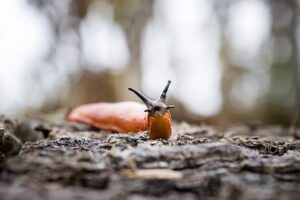Why Slugs Are a Concern
Learn how to get rid of slugs. Slugs are often considered pests in the world of gardening and landscaping because of their voracious appetites, which can lead to significant damage to a wide variety of plants. These mollusks tend to feed on leaves, flowers, and vegetables, sometimes destroying entire seedlings, which can be particularly disheartening to gardeners and homeowners who invest time and care into cultivating their gardens. Additionally, slugs are nocturnal and highly resilient, making them an elusive threat that is difficult to deter and control.
Understanding Slug Behavior
Slugs thrive in damp, cool environments and are especially active during the night or on overcast days. They prefer to reside beneath rocks, logs, and garden debris. Recognizing their behavior patterns is crucial for effectively targeting and mitigating their presence in the garden. By understanding their preferences and habits, gardeners can implement more strategic methods to safeguard their plants and reduce the suitable habitat for slugs within the garden.
Factors That Attract Slugs to Gardens
Slugs are attracted to areas that provide them with the conditions necessary for their survival and reproduction. Moist environments are particularly inviting for these creatures, which is why overwatered gardens, compost heaps, and piles of leaves can often become hotspots for slug activity. Organic mulch, while beneficial for plants, can also serve as prime slug habitat by retaining moisture and providing shelter. Gardens that are located near dense shrubberies or fields can naturally experience more slug problems, as these areas provide an abundant source of concealment. Poorly drained soils or gardens that are watered late in the day create damp conditions that are ideal for slugs to come out and feed during the night. By identifying and reducing these attractants, gardeners can take proactive steps to minimize the presence of slugs in their outdoor spaces.
Natural Predators for Slugs
One of the most effective natural solutions to slug infestations is the encouragement of predatory species within the garden ecosystem. These predators include:
- Birds: Many bird species, such as thrushes, blackbirds, and starlings, feed on slugs, playing a vital role in controlling their populations.
- Frogs and Toads: These amphibians are natural slug predators and can consume large quantities, especially during the damp evening hours when slugs are most active.
- Beetles: Ground beetles, particularly the rove and carabid beetles, are known for their voracious appetite for slugs and can provide substantial control when present in good numbers.
- Hedgehogs: Hedgehogs feed on a variety of garden pests including slugs, making them a gardener’s ally in slug control.
- Nematodes: These microscopic parasites can be introduced into the soil where they infect and kill slugs, providing a biological control method.
Promoting a habitat that welcomes these natural predators can help maintain a balanced garden ecosystem and reduce reliance on chemical controls for slug management.
Barriers and Repellents
Implementing physical barriers can be a practical approach to preventing slug access to garden plants. Creating barriers that are difficult or uncomfortable for slugs to cross can effectively safeguard plants. Some common physical barriers include:
- Copper Tape: When slugs come into contact with copper, a natural electrical charge is produced, repelling them. Wrapping copper tape around the base of plant containers or raised beds can deter slugs.
- Sharp Grit: Spreading a border of sharp grit material such as crushed eggshells or diatomaceous earth around plants can create an abrasive surface that slugs prefer to avoid.
- Sandpaper or Rough Material: Rings of sandpaper or similarly rough materials can form a barrier that slugs are reluctant to cross due to its texture.
Natural Repellents for Slugs
Natural repellents, on the other hand, often involve substances that are unpleasant to slugs but do not necessarily harm them:
- Coffee Grounds: The caffeine in coffee grounds has been suggested as a mild natural repellent for slugs.
- Herbs: Certain strong-smelling herbs like rosemary and lavender can be grown around the garden to deter slugs.
Chemical repellents and slug baits are widely available, but their use requires careful consideration to avoid harm to non-target species and the environment:
- Metaldehyde: This is a common chemical found in slug pellets, but it is toxic to a wide range of animals including pets and wildlife if ingested.
- Iron Phosphate: A safer alternative to metaldehyde, iron phosphate baits are toxic to slugs but considered much less harmful to other animals.
When using repellents of any kind, it is essential to follow application instructions closely and consider the broader impact on the garden ecosystem and local wildlife.
Cultural Practices for Snails
In addition to physical and natural repellents, incorporating certain cultural practices can significantly reduce slug populations in gardens:
- Garden Cleanliness: Regularly removing dead leaves, weeds, and other debris from the garden eliminates the damp and sheltered hiding spots that slugs favor for daytime refuge. Maintaining a tidy garden space can discourage slugs from taking up residence.
- Watering Schedules: Watering plants in the morning rather than in the evening can be effective in deterring slugs. Since these pests are most active at night and thrive in moist conditions, allowing the soil to dry during the day makes the environment less appealing to them.
Implementing these strategies not only disrupts the habitat preferences of slugs but also promotes overall garden health and deters other pests.
Organic and Homemade Solutions
Organic and homemade solutions offer environmentally-friendly and cost-effective methods for controlling slug populations:
- Beer Traps: These simple traps can be created using shallow dishes filled with beer, which is then buried at ground level throughout the garden. The yeast in the beer attracts slugs, leading them to fall into the dish and drown.
- Diatomaceous Earth: A fine powder made from the fossilized remains of diatoms, diatomaceous earth acts as a natural abrasive and desiccant. When sprinkled around plants, it can deter and even kill slugs by causing physical damage to their moist bodies.
By employing these organic methods, gardeners can protect their plants while maintaining ecological balance and avoiding harm to beneficial insects and wildlife.
Chemical Control for Snails
While organic solutions are preferential for many gardeners, severe infestations may necessitate the use of chemical slug baits. These should be used cautiously and as a last resort:
- Iron Phosphate Baits: Products containing iron phosphate are safer alternatives to more toxic chemicals, and are effective in killing slugs. Scatter the granules near affected plants according to the manufacturer’s instructions, typically in the evening when slugs begin to emerge.
- Metaldehyde Baits: Metaldehyde is highly effective against slugs but can be toxic to wildlife and pets if ingested. Use it sparingly, and place baits under boards or tiles to limit exposure. Always follow the label’s safety guidelines closely.
Precautions when using chemical slug baits include:
- Protecting Wildlife: If possible, choose products that are certified as wildlife-friendly, and apply them in a way that minimizes access by non-target animals.
- Timing: Apply baits after rain or watering the garden, as this is when slugs are most active and the bait is most effective.
- Proper Storage: Keep the bait in its original packaging, securely closed, and stored out of reach of children and pets.
Remember, the judicious use of any chemical control is crucial to prevent harm to the surrounding ecosystem and should align with integrated pest management practices.
Maintenance and Prevention
To ensure lasting protection against slug infestations, ongoing garden maintenance is critical. Here are some tips to keep your garden slug-free:
- Remove Debris: Regularly clear your garden of leaves, fallen branches, and other organic waste that can provide hiding spots for slugs.
- Soil Cultivation: Periodically turning the soil can expose slug eggs to the elements, reducing their chances of survival.
- Watering Schedule: Water your plants in the morning rather than the evening. Slugs are nocturnal and thrive in moist conditions, so a drier environment at night is less inviting.
- Plant Selection: Grow plants that are known to be less attractive to slugs, such as those with strong scents or hairy leaves, to naturally deter them from your garden.
- Barriers and Traps: Consistently check and maintain physical barriers, such as copper tape and sharp grit, and traps that you have set up to discourage slug entry and capture any intruders.
These preventative measures, when implemented regularly, can help maintain the health of your garden and lessen the likelihood of future slug invasions.
Conclusion
In conclusion, effective slug control in your garden requires a multifaceted approach. Integrating multiple methods such as chemical baits, environmental modifications, and physical barriers ensures a comprehensive defense against these pests. This integration not only targets adult slugs but also helps to disrupt the life cycle, reducing future populations. By consistently applying these varied techniques, gardeners can create an environment that is decidedly less appealing to slugs, thus protecting their plants and preserving the biodiversity of their garden ecosystem.


